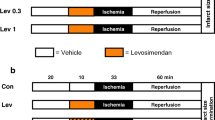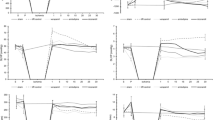Abstract
The aim of this study was to assess early preconditioning protection against stunning in conscious sheep and analyze the role of ATP-dependent potassium (KATP) channels in the protective mechanism. Chronically instrumented animals were submitted to a 12 min reversible ischemia and 2 h reperfusion. Early preconditioning, consisting of six 5 min occlusion–5 min reperfusion periods, followed by 45 min normoperfusion before the prolonged ischemia protected against stunning (P < 0.01). In these experimental conditions, current agents used to analyze sarcolemmal (sKATP) and mitochondrial (mKATP) KATP channels could not clearly establish their participation in the protective mechanism. At doses that inhibit sKATP channels they were unable to block preconditioning protection against stunning (glibenclamide) or conversely, blocked preconditioning at doses that do not inhibit these channels (HMR1098). Moreover, both mKATP channel agonists (diazoxide) and antagonists (5HD) protected against stunning, a response that could be due to their effect via an alternative mitochondrial pathway.








Similar content being viewed by others
References
Mosca SM, Gelpi RJ, Cingolani HE (1993) Dissociation between myocardial relaxation and diastolic stiffness in the stunned heart: its prevention by ischemic preconditioning. Mol Cell Biochem 129:171–178. doi:10.1007/BF00926365
Ovize M, Przylenk K, Hale SL et al (1992) Preconditioning does not attenuate myocardial stunning. Circulation 85:2247–2254
Berg JS, Christensen BO, Aagaard S et al (2005) Ischaemic preconditioning causes increased myocardial vascular resistance but no myocardial contractility changes in pigs after OPCAB. Interact Cardiovasc Thorac Surg 4:207–211. doi:10.1510/icvts.2004.091736
del Valle HF, Lascano EC, Negroni JA et al (2003) Absence of ischemic preconditioning protection in diabetic sheep hearts: role of sarcolemmal KATP channel dysfunction. Mol Cell Biochem 249:21–30. doi:10.1023/A:1024797530152
Noma A (1983) ATP-regulated K channels in cardiac muscle. Nature 305:147–148. doi:10.1038/305147a0
Gross GJ, Peart JN (2003) KATP channels and myocardial preconditioning: an update. Am J Physiol 285:H921–H930
Garlid KD (2000) Opening mitochondrial K(ATP) in the heart—what happens, and what does not happen. Basic Res Cardiol 95:275–279. doi:10.1007/s003950070046
Gross GJ, Auchampach JA (1992) Blockade of ATP-sensitive potassium channels prevents myocardial preconditioning in dogs. Circ Res 70:223–233
Yao Z, Gross GJ (1994) Effects of the KATP channel opener bimakalim on coronary blood flow, monophasic action potential duration, and infarct size in dogs. Circulation 89:1769–1775
Schulz R, Rose J, Heusch G (1994) Involvement of activation of ATP dependent potassium channels in ischemic preconditioning in swine. Am J Physiol 267:H1341–H1352
Gross GJ, Fryer RM (1999) Sarcolemmal versus mitochondrial ATP channels and myocardial preconditioning. Circ Res 84:973–979
O’Rourke B (2000) Myocardial KATP channels in preconditioning. Circ Res 87:845–855
Jung O, Englert HC, Jung W et al (2000) The KATP channel blocker HMR 1883 does not abolish the benefit of ischemic preconditioning on myocardial infarct mass in anesthetized rabbits. Naunyn Schmiedebergs Arch Pharmacol 361:445–451. doi:10.1007/s002109900212
Pain T, Yang XM, Critz SD et al (2000) Opening of mitochondrial K(ATP) channels triggers the preconditioned state by generating free radicals. Circ Res 87:460–466
Fryer RM, Ellis JT, Hsu AK et al (2000) Ischemic preconditioning in rats: role of mitochondrial KATP channel in preservation of mitochondrial function. Am J Physiol 278:H305–H312
Cohen MV, Yang XM, Liu GS et al (2001) Acetylcholine, bradykinin, opioids, and phenylephrine, but not adenosine, trigger preconditioning by generating free radicals and opening mitochondrial K(ATP) channels. Circ Res 89:273–278. doi:10.1161/hh1501.094266
Forbes RA, Steenbergen C, Murphy E (2001) Diazoxide-induced cardioprotection requires signaling through a redox-sensitive mechanism. Circ Res 88:802–809. doi:10.1161/hh0801.089342
Das B, Sarkar C (2005) Is the sarcolemmal or mitochondrial K(ATP) channel activation important in the antiarrhythmic and cardioprotective effects during acute ischemia/reperfusion in the intact anesthetized rabbit model? Life Sci 77:1226–1248. doi:10.1016/j.lfs.2004.12.042
du Toit EF, Genis A, Opie LH et al (2008) A role for the RISK pathway and K(ATP) channels in pre- and post-conditioning induced by levosimendan in the isolated guinea pig heart. Br J Pharmacol 154:41–50. doi:10.1038/bjp.2008.52
del Valle HF, Lascano EC, Negroni JA (2002) Ischemic preconditioning protection against stunning in conscious diabetic sheep: role of glucose, insulin, sarcolemmal and mitochondrial KATP channels. Cardiovasc Res 55:642–659. doi:10.1016/S0008-6363(02)00468-6
Lascano EC, del Valle HF, Negroni JA (2006) Role of the cyclooxygenase pathway in the protection against postischemic stunning in conscious sheep. Mol Cell Biochem 289:91–100. doi:10.1007/s11010-006-9152-4
Negroni JA, Lascano EC, del Valle HF et al (2002) ATP-sensitive potassium channels do not have a main role in mediating late preconditioning protection against arrhythmias and stunning in conscious sheep. Basic Res Cardiol 97:55–64. doi:10.1007/s395-002-8388-7
Lascano EC, Negroni JA, del Valle HF (2002) Ischemic shortening of action potential duration as a result of KATP channel opening attenuates myocardial stunning by reducing calcium influx. Mol Cell Biochem 236:53–61. doi:10.1023/A:1016198011919
Negroni JA, Lascano EC, del Valle HF (2007) Glibenclamide action on myocardial function and arrhythmia incidence in the healthy and diabetic heart. Cardiovasc Hematol Agents Med Chem 5:43–53
Zhu BM, Miyamoto S, Nagasawa Y et al (2003) Effect of the sarcolemmal K(ATP) channel blocker HMR1098 on arrhythmias induced by programmed electrical stimulation in canine old myocardial infarction model: comparison with glibenclamide. J Pharmacol Sci 93:106–113. doi:10.1254/jphs.93.106
Niwano S, Inuo K, Morohoshi Y et al (2004) Mexiletine protects myocardium during acute ischemia by opening sarcolemmal K-ATP channel: studies in closed-chest acute ischemia model in rabbits. J Cardiovasc Pharmacol 44:639–644. doi:10.1097/00005344-200412000-00003
Auchampach JA, Maruyama M, Cavero I et al (1992) Pharmacological evidence for a role of ATP-dependent potassium channels in myocardial stunning. Circulation 86:311–319
Miyamae M, Fujiwara H, Kida M et al (1993) Preconditioning improves energy metabolism during reperfusion but does not attenuate myocardial stunning in porcine hearts. Circulation 88:223–234
Cohen MV, Liu GS, Downey JM (1991) Preconditioning causes improved wall motion as well as smaller infarcts after transient coronary occlusion in rabbits. Circulation 84:341–349
Fralix TA, Steenbergen C, London RE et al (1993) Glibenclamide does not abolish the protective effect of preconditioning on stunning in the isolated perfused rat heart. Cardiovasc Res 27:630–637. doi:10.1093/cvr/27.4.630
Schaper W (1971) Coronary occlusion in mammals. In: Black DAK (ed) Clinical studies. Vol 1: the collateral circulation of the heart. North-Holland, Amsterdam, pp 19–28
Suzuki M, Saito T, Sato T et al (2003) Cardioprotective effect of diazoxide is mediated by activation of sarcolemmal but not mitochondrial ATP-sensitive potassium channels in mice. Circulation 107:682–685. doi:10.1161/01.CIR.0000055187.67365.81
Garlid KD, Paucek P, Yarov-Yarovoy V et al (1996) The mitochondrial KATP channel as a receptor for potassium channel openers. J Biol Chem 271:8796–8799. doi:10.1074/jbc.271.15.8796
Hausenloy DJ, Wynne AM, Yellon DM (2007) Ischemic preconditioning targets the reperfusion phase. Basic Res Cardiol 102:445–452. doi:10.1007/s00395-007-0656-1
Pagel PS, Krolikowski JG, Pratt PF Jr et al (2008) Reactive oxygen species and mitochondrial adenosine triphosphate-regulated potassium channels mediate helium-induced preconditioning against myocardial infarction in vivo. J Cardiothorac Vasc Anesth 22:554–559. doi:10.1053/j.jvca.2008.04.005
Brennan JP, Southworth R, Medina RA et al (2006) Mitochondrial uncoupling, with low concentration FCCP, induces ROS-dependent cardioprotection independent of KATP channel activation. Cardiovasc Res 72:313–321. doi:10.1016/j.cardiores.2006.07.019
An J, Bosnjak ZJ, Jiang MT (2007) Myocardial protection by isoflurane preconditioning preserves Ca2+ cycling proteins independent of sarcolemmal and mitochondrial KATP channels. Anesth Analg 105:1207–1213. doi:10.1213/01.ane.0000281053.13929.d0
Shigematsu S, Sato T, Abe T et al (1995) Pharmacological evidence for the persistent activation of ATP-sensitive K+ channels in early phase of reperfusion and its protective role against myocardial stunning. Circulation 92:2266–2275
Maruyama I, Tomiyama Y, Maruyama K et al (2006) Effects of mitiglinide and sulfonylureas in isolated canine coronary arteries and perfused rat hearts. Eur J Pharmacol 531:194–200. doi:10.1016/j.ejphar.2005.11.060
Grover GJ, Dzwonczyk S, Sleph PG et al (1993) The ATP-sensitive potassium channel blocker glibenclamide (glyburide) does not abolish preconditioning in isolated ischemic rat hearts. J Pharmacol Exp Ther 265:559–564
Gross GJ, Hsu A, Falck JR, Nithipatikom K (2007) Mechanisms by which epoxyeicosatrienoic acids (EETs) elicit cardioprotection in rat hearts. J Mol Cell Cardiol 42:687–691. doi:10.1016/j.yjmcc.2006.11.020
Lim KHH, Javadov SA, Das M et al (2002) The effects of ischaemic preconditioning, diazoxide and 5-hydroxydecanoate on rat heart mitochondrial volume and respiration. J Physiol 545:961–974. doi:10.1113/jphysiol.2002.031484
Churchill EN, Mochly-Rosen D (2007) The roles of PKCδ and ε isoenzymes in the regulation of myocardial ischaemia/reperfusion injury. Biochem Soc Trans 35:1040–1042. doi:10.1042/BST0351040
Miller MJ (2001) Preconditioning for cardioprotection against ischemia reperfusion injury: the roles of nitric oxide, reactive oxygen species, heat shock proteins, reactive hyperemia and antioxidants—a mini review. Can J Cardiol 17:1075–1082
Schulz R, Kelm M, Heusch G (2004) Nitric oxide in myocardial ischemia/reperfusion injury. Cardiovasc Res 61:402–441. doi:10.1016/j.cardiores.2003.09.019
Gelpi RJ, Morales C, Cohen MV, Downey JM (2002) Xanthine oxidase contributes to preconditioning’s preservation of left ventricular developed pressure in isolated rat heart: developed pressure may not be an appropriate end-point for studies of preconditioning. Basic Res Cardiol 97:40–46. doi:10.1007/s395-002-8386-0
Chen XB, Orskov ER, Hovell FD (1990) Excretion of purine derivatives by ruminants: endogenous excretion, differences between cattle and sheep. Br J Nutr 63:121–129. doi:10.1079/BJN19900097
Acknowledgments
The authors wish to thank María Inés Besansón and Pedro Iguain for performing the anesthesia and follow-up of the animals during surgery, Marta Tealdo, and technicians: Juan Mansilla, Osvaldo Sosa, and Juan Ocampo for animal care, and Julio Martínez and Fabián Gauna for technical assistance. We also gratefully acknowledge the donation of HMR1098 by Sanofi-aventis.
Author information
Authors and Affiliations
Corresponding author
Rights and permissions
About this article
Cite this article
Lascano, E.C., Negroni, J.A. & del Valle, H.F. Early preconditioning protection against stunning in conscious sheep. Role of KATP channels. Mol Cell Biochem 331, 247–257 (2009). https://doi.org/10.1007/s11010-009-0166-6
Received:
Accepted:
Published:
Issue Date:
DOI: https://doi.org/10.1007/s11010-009-0166-6




